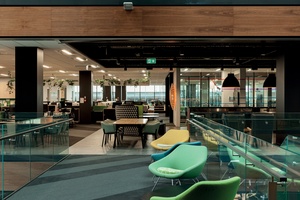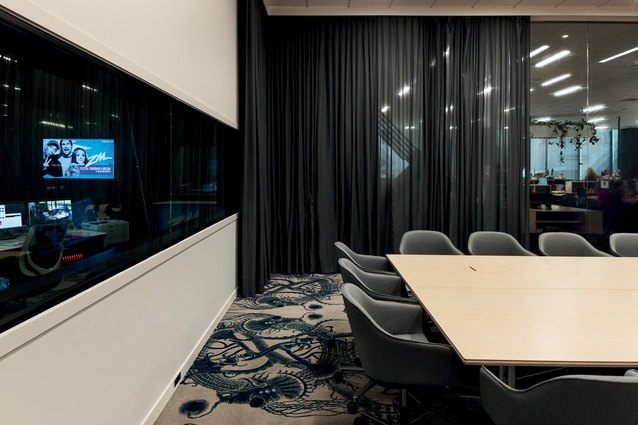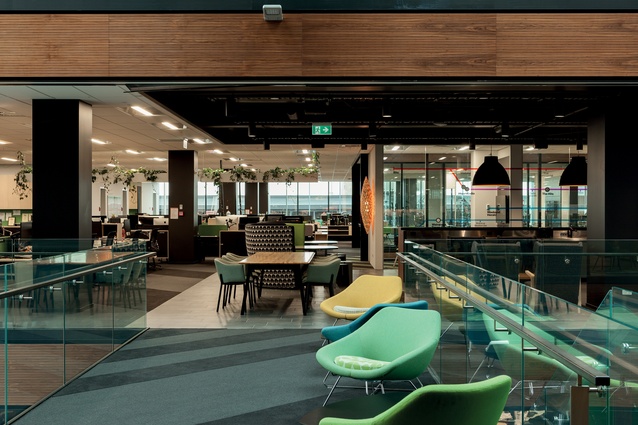Spatial report
Sarosh Mulla steps into NZME’s new headquarters to continue exploring how changes in news delivery and consumption are affecting the design of the modern newsroom.
I entered the new offices of NZME on a Wednesday night, just at sundown. It was a cool and clear evening, with a soft autumnal light falling over the face of the building. I was approaching the building through an empty west-facing courtyard when I felt someone’s eyes on me. About 30 metres away, I could see a bald man, sitting on a bar stool, peering at me from within the glass corner of the building’s ground floor. The lights were on inside and he appeared to be on display for those passing by. It was Leigh Hart, Radio Hauraki’s drive time DJ and he looked at me with his trademark look of quizzical skepticism – trapped and gazing out on my relative freedom.
All of the radio studios are now available to view in NZME’s new home. Radio personalities, once known for their pronunciation but hardly seen by the public, are now known for public appearances, television cross overs, and live to air stunts. They are now deemed worthy of viewing across media platforms and in the physical space of the city.
It is not just this new-found persona of radio presenters but many other traditions media outfits worldwide have and continue to change. These days we expect different things from our media, with a greater emphasis on personality, speed and brand. The new home of NZME demonstrates these changing expectations while also communicating its power as a singular, collected media organisation. This is, after all, the biggest studio building to have taken place in New Zealand in decades.

Internationally, the only studio redevelopment in recent years that has been larger than the new NZME space has been the rehousing of the BBC in their $1b Broadcasting House. This project has recently relocated 6,000 staff into a new building and like the NZME project, this development for the BBC has been all about the centralisation of news content generation for cross platform dissemination. But, it’s also been about trying to understand the changing business of reporting news and trying to let this drive the way spaces are designed.
Chris Kane, former CEO of BBC Commercial Projects and Head of BBC Workplace, played a central role in the development of the new building for the BBC and, at the time of writing, was scheduled to arrive in Auckland for CoreNet’s symposium, ‘The Age of the City’. Kane’s approach to the project was drawn out of an understanding of how the media landscape has changed and the need to empower journalists.
“It is really all about people and place, a shift from just focusing on the building to one focusing on enabling work”, notes Kane. This is an approach that is demonstrable in Kane’s work for the BBC and has provided a sea change in the way newsrooms are considered around the world, including those contained within NZME’s new home.
The interior of the NZME building is modern and brand-centric with a particular forwardness easily compared to its extrovert presenters. Three spaces are particularly important in demonstrating the culture of the company. The first of these was the large reception space on the ground floor with a large, omni-directional, mirror polished reception desk and flanked by a long bar. The bar is substantial and the AV system in place demonstrates NZME’s desire to present to, and possibly even party with, the public.
Directly off this reception space is a large boardroom, with uncharacteristically swirling chinoiserie-inspired carpet. The boardroom looks over the top of the producers’ suite at the radio studios that line the west side of the building. One might infer that management is keeping a beady eye on the shock jocks at play, or perhaps, they wish to be close to the warm glow of celebrity. Either way, the connection, through all of its layers of glass, is potent.
Above the ground floor the offices of the New Zealand Herald is more recognisable as a newsroom. There are long communal kitchens which supply the newsroom, with what one can only imagine is a prodigious quantity of coffee. The arrangement of the floorplate makes efficient use of the space, while creating a clear space for group discussions, surrounded by screens with feeds from major international news sources. The analytics of the readership is carefully monitored, so that spikes in article views can be carefully scrutinised.

Entertainment is treated as news in these spaces. As we know, to rant and rave against this phenomenon is to swim against the tide. But what is remarkable is the absolute reflection of the cultural change in media organisations in their spatial design. The designers have absorbed the new direction set out by NZME’s leadership and applied it without reservation, or nostalgia.
For those of us who still like hearing someone say, “answer the question Prime Minister”, there are still signs of ‘real journalism’ occurring here. As if evidence of this, the New Zealand Herald newsroom is actually full of busy desks. Desks with names on them. Desks with pictures of family members pinned up next to monitors. Desks with signs of half-finished interviews and Official Information Act requests. Journos are still here and they still need desks! What a wonderful relief to see that within all of the codified brand communication and commercial conglomeration, NZME and their designers haven’t totally adopted ‘activity based working’ without question or critique.
Within their new space NZME have taken the opportunity to reflect their place as a media conglomerate, rather than a singular outlet. The range of brands collected under the NZME banner caters to a wide variety of demographics and interests. The collection of brands and spaces is communicated as a source of synergistic efficiency and collaboration.
For example, journalists from the New Zealand Herald supply stories to other brands, across print, digital and radio formats. The spaces provide for this as a central goal of the business. But the questions of homogenisation and the independence of media outlets remain unanswered, particularly at the time of writing, as a merger with Fairfax seems to be imminent.
The potential to singularly control so many media outlets is seen by many as counter to the ideals of a functioning democracy as it undercuts a primary function of the news media, to question and hold to account those with power. The spatial environment designed at NZME takes no stand on this issue. Instead of offering to the public a vision of journalism with integrity to the street, NZME has favoured the caging of Leigh Hart, and the like, in a clear demonstration of entertainment over journalism.
Read Sarosh Mulla’s article on the Newshub studios here.












